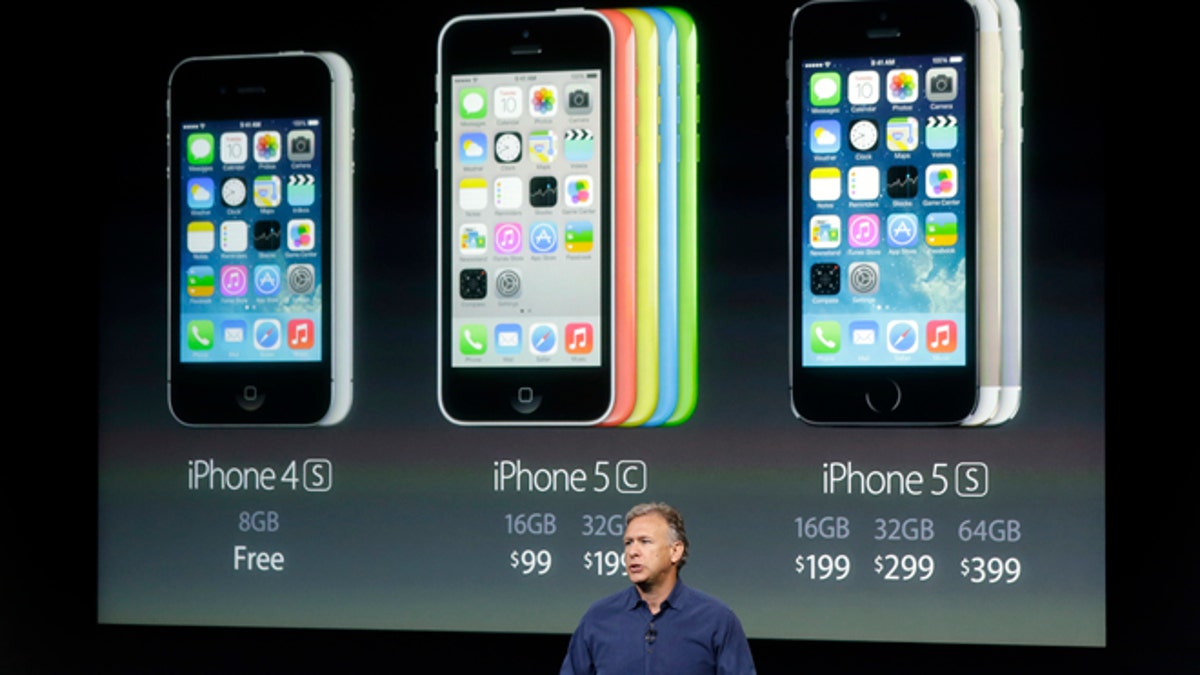
Phil Schiller, Apple's senior vice president of worldwide product marketing, speaks on stage during the introduction of the new iPhone 5c and 5s in Cupertino, Calif., Tuesday, Sept. 10, 2013. (AP Photo/Marcio Jose Sanchez) (AP2013)
Apple's new iPhone 5S and 5C go on sale Friday, and while the 5 is being discontinued, below are how the new phones compare.
All three phones have a touch screen measuring 4 inches diagonally, with a resolution of 326 pixels per inch. That pixel density is better than Apple's iPads, though not as good as Samsung Electronic Co.'s flagship Galaxy S4. The iPhone 5 and 5S are identical in size and weight, while the 5C is slightly bigger and heavier. The iPhone 5S is identical in price to what the iPhone 5 cost when it was introduced last year, while the 5C is $100 cheaper.
Battery life is comparable. Talk time is boosted on the 5C and 5S, as is Internet use over LTE cellular connections. Video playback and Internet use over Wi-Fi remain the same. Like all previous models, the battery on the new phones can be replaced only by service personnel.
The main differences:
— Only the iPhone 5S has a fingerprint sensor. The home button of the 5S recognizes your prints and can use that instead of a four-digit passcode to unlock the phone.
— The main camera on the 5S is better at picking up light, which is useful for night and indoor shots. Although all three phones have 8-megapixel cameras, individual pixels on the 5S are larger, and the camera's shutter can open wider. Combined, Apple says that translates to a 33 percent improvement in light sensitivity.
— The flash on the 5S is better, too. Unlike other cameras, iPhones or otherwise, the flash on the 5S shoots two different lights at once — one whitish and the other amber. The iPhone adjusts the combination automatically to account for ambient lighting conditions. That results in better skin tones and more natural colors, as the normal flash sometimes overpowers whatever light is naturally there.
— The front-facing camera on both the 5C and the 5S are better. Although the cameras remain at 1.2 megapixels, the pixel sizes on both are larger.
— The 5S can shoot slow-motion video and take up to 10 photos per second. The 5 and the 5C can't do slow motion. The 5C does allow for continuous shooting, but only at about 2.5 shots per second.
— The A7 processor used in the 5S is faster than the A6 found in the 5 and the 5C. Apps and Web pages typically open a blink of an eye faster. The 5S boots about five seconds faster than the 5C.
— The A7 on the 5S can handle data more efficiently with a 64-bit format, akin to what's found on desktop computers, rather than the 32 bits traditionally used in phones. Games and other graphic-intensive apps can take advantage of this. The 5S also has a companion processor, called M7, for motion-related tasks. That allows for fitness apps to run without draining as much battery. Apps taking advantage of either of these improvements are still being developed, though.
— The 5S and the 5C are compatible with more 4G LTE frequency bands — up to 13, instead of a maximum five before. That means the phone is more likely to work with higher speeds wherever you go. However, there are more than 40 cellular bands worldwide, the bulk for LTE, so a version bought in one country might not work for high speeds everywhere around the world. If that happens, you'll need to use the slower 3G and GSM networks.
— Both the 5C and the 5S come with iOS 7, which offers a new look to icons along with new features such as a Control Center for easy access to frequently used settings and apps. Older phones can be upgraded to iOS 6 for free, although Apple says some features won't work with all models.
— The 5S comes in a choice of silver, gold or gray, while the 5C is available in green, blue, yellow, pink or white. On the 5C, the background wallpaper on the screen matches the color chosen. If sunny yellow for the yellow model gets annoying, you can change it to Apple's standard wallpaper, or any photo of your choosing. Or spend $100 more for the 5S and the normal wallpaper that comes with it.
Based on reporting by The Associated Press.
Follow us on twitter.com/foxnewslatino
Like us at facebook.com/foxnewslatino
